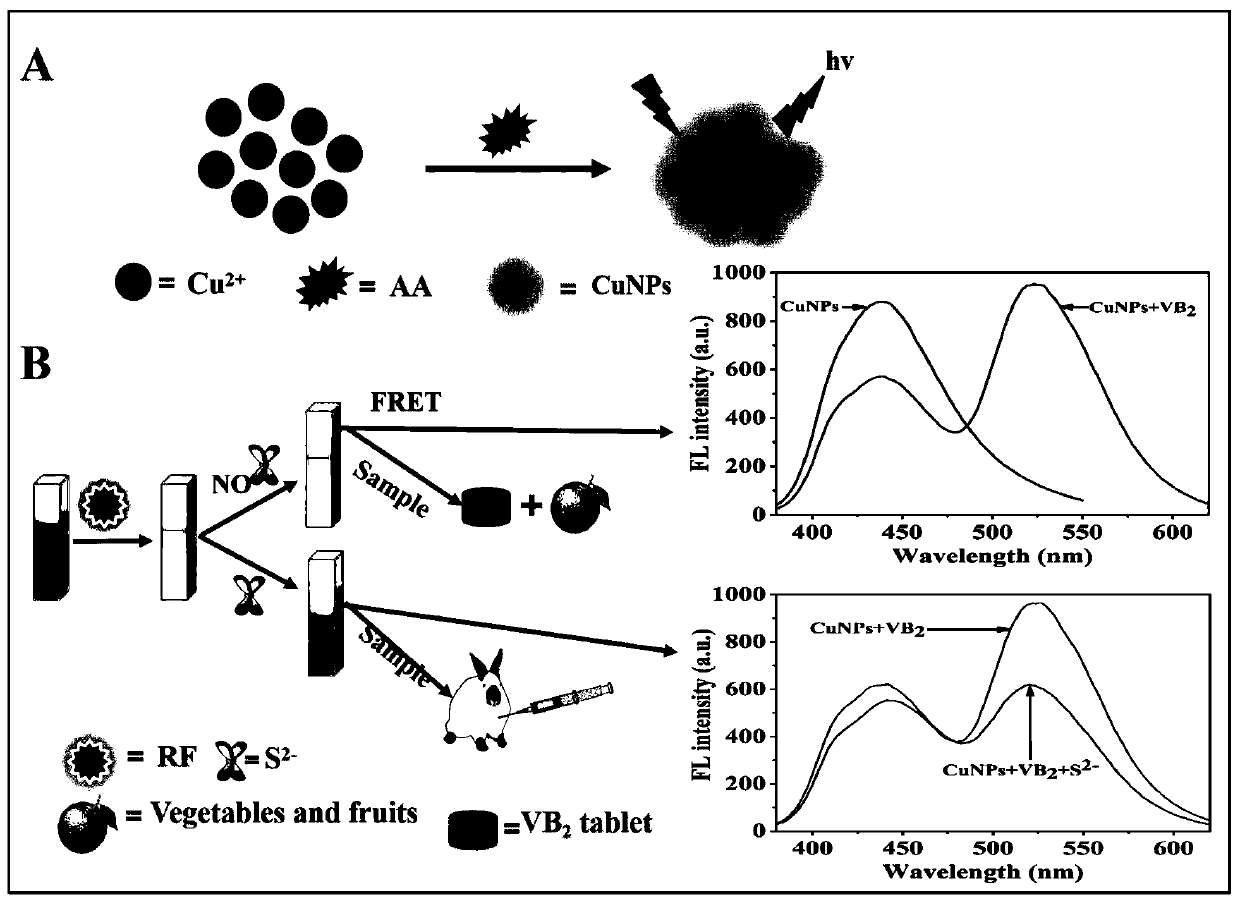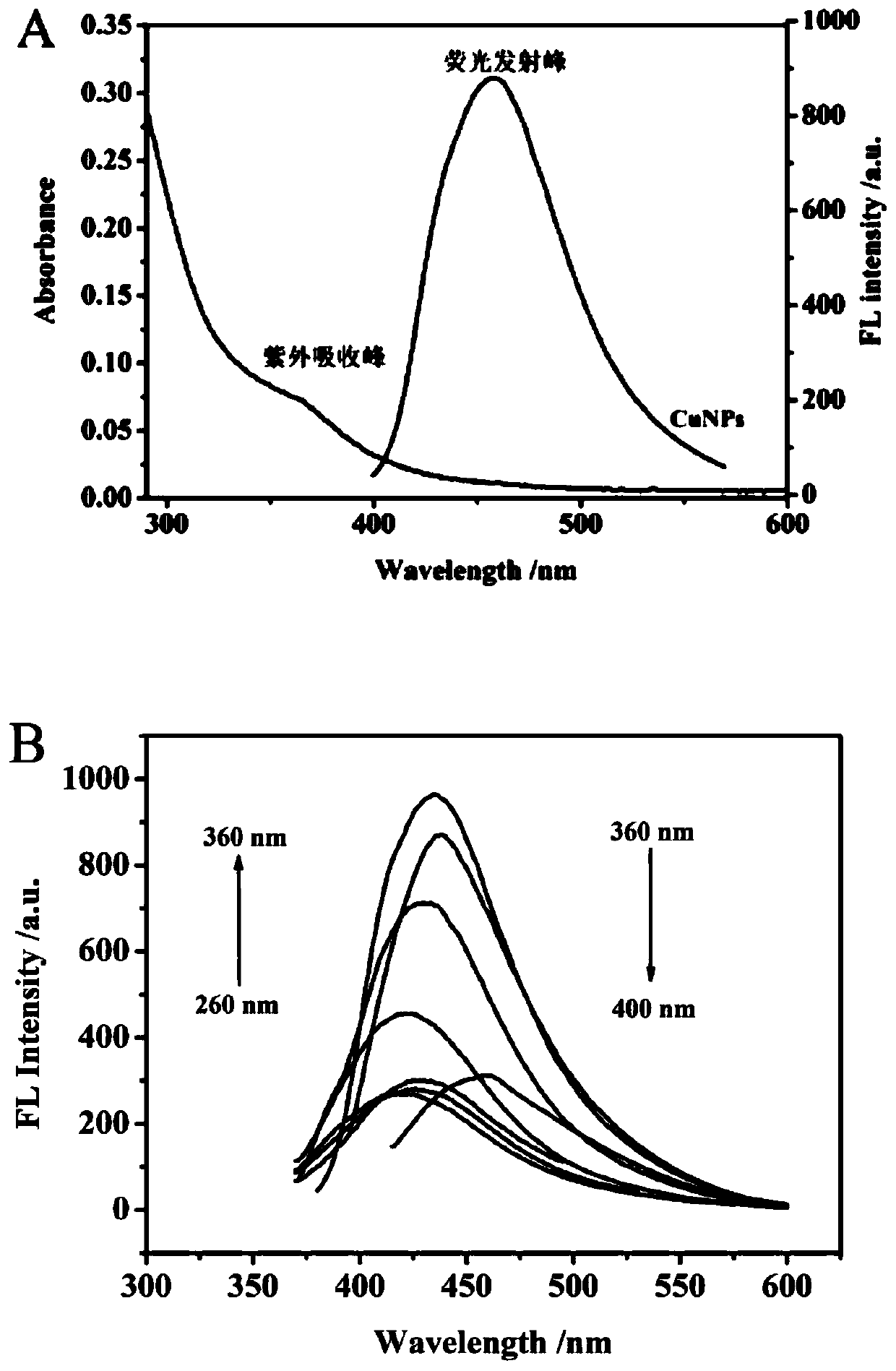Fluorescent copper nanoparticles, preparation method thereof and application in detecting content of riboflavin and sulfur ions
A technology of nanoparticles and fluorescent copper, which is applied in the direction of measuring devices, nanotechnology, fluorescence/phosphorescence, etc., and can solve the problems of complex sample processing, high cost of raw materials, and expensive instruments
- Summary
- Abstract
- Description
- Claims
- Application Information
AI Technical Summary
Problems solved by technology
Method used
Image
Examples
preparation example Construction
[0045] 2.1 Preparation of copper nano-solution CuNPs
[0046] Weigh 32 mg of anhydrous copper sulfate, add 2 mL of 0.5 mol / L NaOH solution, add 20 mL of ultrapure water and stir for 2 min, transfer to a rotary evaporator (the rotary evaporator is wrapped in a black bag), turn off the condensation switch, and close the exhaust plug. Add 20mL of 0.1 mol / L ascorbic acid solution, the color of the solution turns egg yellow, rotate at 50°C for 10 minutes, adjust the pH to pH=8-9 with 0.5mol / L NaOH solution, continue to rotate at 50°C for 15 hours, the color of the solution finally changes to Greenish brown, CuNPs formed, stored in a 4°C refrigerator in the dark.
[0047] 2.2 Formation of fluorescence resonance energy
[0048] VB2 was detected fluorescently in PBS buffer solution at pH=7.5 (0.1M) at room temperature. The specific process is as follows: first pipette 25 μl (36.025 mM) CuNPs solution into a quartz cuvette and add 3 mL (0.1M, pH=7.5) of PBS buffer solution, then add ...
Embodiment 1
[0139] 1 Preparation of copper nano-solution CuNPs
[0140] Weigh 32 mg of anhydrous copper sulfate, add 2 mL of 0.5 mol / L NaOH solution, add 20 mL of ultrapure water and stir for 2 min, transfer to a rotary evaporator (the rotary evaporator is wrapped in a black bag), turn off the condensation switch, close the exhaust plug, add 20mL 0.1mol / L ascorbic acid solution, the color of the solution turns egg yellow, rotate at 50°C for 10min, adjust the pH to pH=8 with 0.5mol / L NaOH solution, continue to rotate at 50°C for 15 hours, the color of the solution finally turns greenish brown, CuNPs Formed, protected from light and stored in a 4°C refrigerator.
[0141] 2VB 2 concentration detection
[0142] The oranges are pre-treated by crushing them first, centrifuging them, taking the supernatant, preparing the concentration required for the test, and refrigerating them in the refrigerator for later use.
[0143] Take 25μL (36.025uM) CuNPs solution, add 3mL PBS (pH=7.5) and 300μL of...
Embodiment 2
[0145] 1 Preparation of copper nano-solution CuNPs
[0146] Weigh 30 mg of anhydrous copper sulfate, add 4 mL of 0.1mol / L NaOH solution, add 20 mL of ultrapure water and stir for 2 min, transfer to a rotary evaporator (the rotary evaporator is wrapped in a black bag), turn off the condensation switch, close the exhaust plug, add 20mL 0.06mol / L ascorbic acid solution, the color of the solution turns egg yellow, rotate at 90°C for 10min, adjust the pH to pH=5 with 0.5mol / L NaOH solution, continue to rotate at 90°C for 17 hours, the color of the solution finally turns greenish brown, CuNPs Formed, protected from light and stored in a 4°C refrigerator.
[0147] 2VB 2 concentration detection
[0148] The oranges are pre-treated by crushing them first, centrifuging them, taking the supernatant, preparing the concentration required for the test, and refrigerating them in the refrigerator for later use.
[0149] Take 25μL (36.025uM) CuNPs solution, add 3mL PBS (pH=7.5) and 300μL of...
PUM
| Property | Measurement | Unit |
|---|---|---|
| size | aaaaa | aaaaa |
| particle size | aaaaa | aaaaa |
| recovery rate | aaaaa | aaaaa |
Abstract
Description
Claims
Application Information
 Login to View More
Login to View More - R&D
- Intellectual Property
- Life Sciences
- Materials
- Tech Scout
- Unparalleled Data Quality
- Higher Quality Content
- 60% Fewer Hallucinations
Browse by: Latest US Patents, China's latest patents, Technical Efficacy Thesaurus, Application Domain, Technology Topic, Popular Technical Reports.
© 2025 PatSnap. All rights reserved.Legal|Privacy policy|Modern Slavery Act Transparency Statement|Sitemap|About US| Contact US: help@patsnap.com



